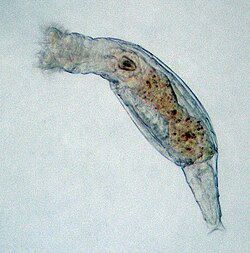| Habrotrocha Temporal range: | |
|---|---|
 | |
| Habrotrocha rosa | |
| Scientific classification | |
| Domain: | Eukaryota |
| Kingdom: | Animalia |
| Phylum: | Rotifera |
| Class: | Bdelloidea |
| Order: | Bdelloida |
| Family: | Habrotrochidae |
| Genus: | Habrotrocha Bryce, 1910 [1] |
| Species | |
Several, including: | |
Habrotrocha is a genus of bdelloid rotifers.
Late Eocene fossils of Habrotrocha in Dominican amber are among the oldest known fossil rotiferans. [2]
Habrotrochid rotifers seem to have persisted for 35 million years with very little change in morphology or ecological role. [3]